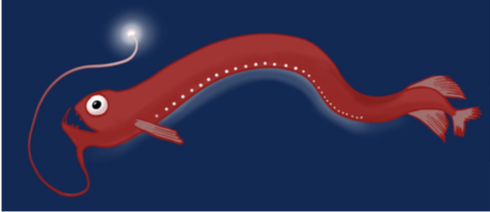The ocean is a big, amazing place, teeming with life and largely unexplored! This FREE pdf lesson includes a fun memory help poster, science experiments, and an easy to learn lesson with several unique creatures from each of the ocean zones (epipelagic, mesopelagic, bathypelagic, abyssopelagic). Also included is a study guide with plenty of fun pictures about the ocean floor, including continental shelf, abyssal plain, mid-ocean ridges and trenches!
Memory Tools
Epi sounds like HAPPY to me! I like to think that the fish in this zone are happy because they get the most sunshine. This is why I drew the fish smiling in the epipelagic zone!
Meso sounds like “MESS OF,” so the octopus in the mesopelagic zone is using his many tentacles to clean up the ocean.
Bathy sounds like BATH. The swordfish which can be found in the bathypelagic zone is enjoying a nice bath-uh-bubbles!
Abyss means “bottomless.” This word is use to describe a dark place that seems to go on forever... which sounds like a good description for much of the ocean! Let’s learn some more about this amazing place.
Epipelagic (0 to 656 feet/ 0-200 meters deep)
Epipelagic means “over the sea.” It is also called the Photic Zone, or Sunshine Zone. Epi, which sounds to me like happy, actually means “on” or “over.” This is the top zone of the ocean. I wonder if the fish in this zone are extra happy because they get the most sunshine! This is the only zone where plants can grow, because they need sunlight for photosynthesis.
Most of the animals (90%) that live in the ocean live in this zone, including every type of invertebrate, sea mammals, and a huge variety of fish. Some fish that can be found in the other ocean zones still come up to the Epipelagic zone at night to feed.
Mesopelagic (656 to 3,300 feet/ 200-1,000 meters deep)
Mesopelagic means “middle sea.” It is also called Disphotic Zone, or Twilight Zone. Meso, even though it reminds me of the word mess, it actually means middle. (You might remember this word from another place called Mesopotamia, which got its name from being in the middle of two rivers.) It is also called the disphotic zone, which means “poorly lit.” This zone gets just a little bit of light during the day, but not enough for plants to grow. The temperature of the water is between 41 to 39 degrees Fahrenheit.
Dragonfish
Most animals in this zone have large eyes, teeth, and jaws, and they tend to be small and thin.
The dragonfish is a smaller fish, only about 6 inches long. It has a long body with a light-up lure attached to its head called a “photophore barbel.” It can flash the barbel light on and off and move it around to catch fish. Because many of the fish that it eats are also bioluminescent it has a black opaque stomach so that the fish in its stomach won’t shine while it is digesting! Other mesopelagic sea animals are the sabertooth fish, sea stars, eels, the pufferfish, and mollusks like octopi, oysters, squid, and scallops.
The Aphotic Zones
Bathypelagic (3,300 to 12,000 feet/ 1,000-4,000 meters deep)
Bathypelagic means “deep sea.” It is also called the Midnight Zone.
The bathypelagic zone and below are considered Aphotic (no light) zones , because sunlight cannot reach these into these zones. The bathypelagic zone is very dark, and this is where you will start finding many creatures with bioluminescence. The most common bioluminescent creature in this zone is called the Lanternfish, which has dots of light lining its body.
Lanternfish
Only 1% of the ocean animals live here, but there is still a large variety of life! Some animals you can find in this zone are the Sperm whale, the giant squid, vampire squid, anglerfish, lobsters, and other crawfish like shrimp. Whales are mammals, so they must go up to breathe air, however the Sperm Whale will dive into the Bathypelagic zone to hunt giant squid. The Giant Squid is around 33 feet in length, which is about the same length as a school bus! They have the largest eyes in the animal kingdom, of 10 inches in length. They use a propulsion system to move their cone shaped body, and steer their bodies with tiny fins.
“...Think of a ship: big as it is and driven by such strong winds, it can be steered by a very small rudder, and it goes wherever the pilot wants it to go.” James 3:4
Abyssopelagic- 12,000 to 20,000 feet deep/ 4,000- 6,000 meters
Abyssopelagic means “bottomless sea.” It also called The Abyss.
The average depth of the ocean is 4,000 meters (2 and 1/2 miles). The water in this zone is very still and very cold, just above freezing (36°F/2°C). Because it is dark and cold, fish move slowly and tend to be transparent, red, or black. Red is a very common creature color in this zone, because it is invisible at this depth. 90% of the creatures in this zone are bioluminescent! The Abyssopelagic zone animals are quite weird and creepy looking, however one adorable creature that you can find in the abyssopelagic zone is called the dumbo octopus. This octopus has big eyes and two big flaps on its head that look like dumbo ears. You can also find deep water corals, the fangtooth fish, deep sea jellyfish, giant tube worms, and slime stars.
The ocean is such a marvelous mysterious place. I hope you enjoy studying this seemingly bottomless wonder with your kids!



